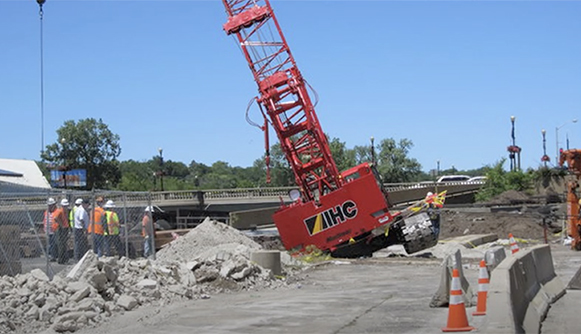
Ground collapse often has a catastrophic outcome. A crane tips when the outrigger sinks, the load is dropped and the crane causes damage. When a crane’s outrigger punctures underground utilities, it damages underground water and sewage lines and can cause a gas line explosion.
To prevent this from happening, first and foremost, it is important to know your surroundings:
What is Type C soil?
"Unconfined compressive strength" means the load per unit area at which a soil will fail in compression. It can be determined by laboratory testing, or estimated in the field using a pocket penetrometer, by thumb penetration tests, and other methods.
"Wet soil" means soil that contains significantly more moisture than moist soil, but in such a range of values that cohesive material will slump or begin to flow when vibrated. Granular material that would exhibit cohesive properties when moist will lose those cohesive properties when wet.
Recently, two UK companies were fined an equivalent of $75,000 following the overturn of a mobile crane in 2009. The companies were each fined $15,000 plus $22,500 in costs and charged with a serious failure in communications. Neither was sure if the job was a crane hire or a contract lift. As such, neither appears to have carried out any proper planning or supervision. One of the crane’s rear outriggers sank into the ground causing the 80-ton crane to overturn.
The HSE investigation found that there was no competent person and no lift plan. Important information including the weights of the load and ground conditions were not considered. The lift was unsafe with the crane overloaded and set up on poor ground. As a result it overturned, with its boom coming down across the site. A larger crane should have been used and larger ground mats were needed to spread the crane’s outrigger loadings, given the poor ground conditions.
A lift plan should have been drawn-up by the competent person and communicated to those involved in the work. The principal contractor should also have taken all reasonable steps to ensure the construction phase plan identified risks to health and safety and included measures to address risks. Any of the “should have but we didn’t” recommendations could have reduced the risk of loss and accident.
What are our OSHA duties?
It is a crane operator’s duty to know what type of site conditions could adversely affect crane operations and consult with lift director on observed potential hazards. Lift Director should ensure that area for crane operations is adequately prepared, with all hazards discovered and marked, including underground utilities (most utility companies will perform a free site survey and mark known utilities at your work site). They should also address poor soil conditions that may impact crane’s operations.
Author: Laura Palmisano, Public Relations and Journalism, Sims Crane and Equipment Co.